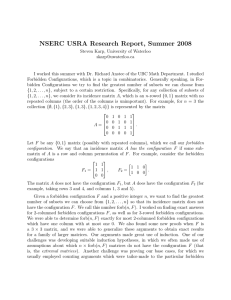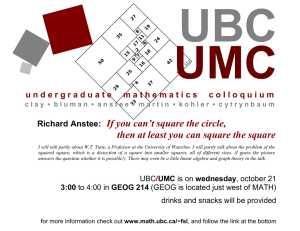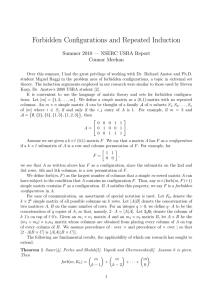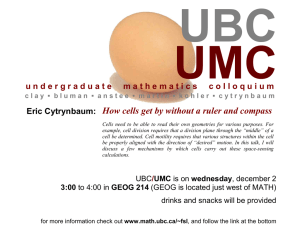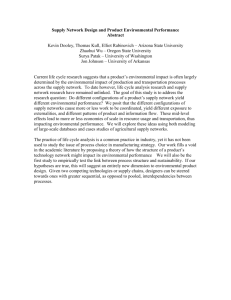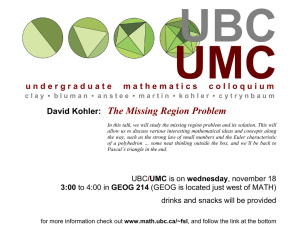Forbidden Configurations Steven Karp (USRA with R.P. Anstee, UBC) CUMC
advertisement
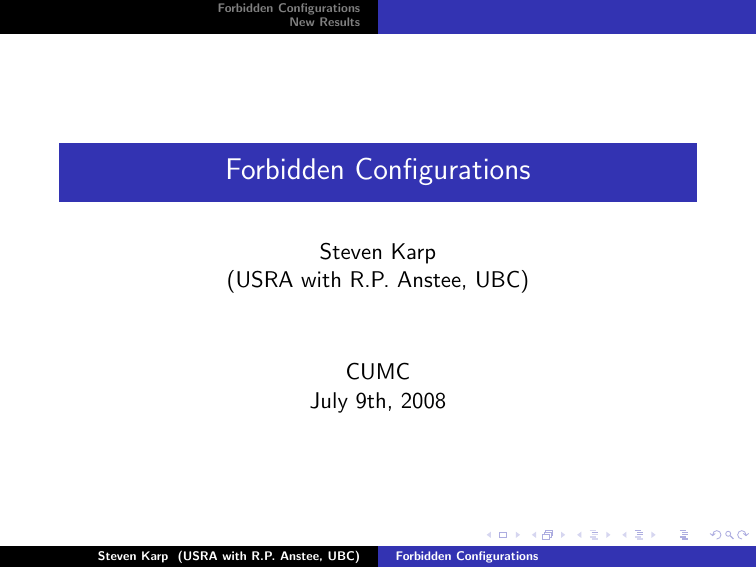
Forbidden Configurations
New Results
Forbidden Configurations
Steven Karp
(USRA with R.P. Anstee, UBC)
CUMC
July 9th, 2008
Steven Karp (USRA with R.P. Anstee, UBC)
Forbidden Configurations
Forbidden Configurations
New Results
What is an Extremal Problem?
Here are some examples of extremal problems:
Steven Karp (USRA with R.P. Anstee, UBC)
Forbidden Configurations
Forbidden Configurations
New Results
What is an Extremal Problem?
Here are some examples of extremal problems:
I
At most how many queens can we place on a chessboard so
that no two attack each other?
Steven Karp (USRA with R.P. Anstee, UBC)
Forbidden Configurations
Forbidden Configurations
New Results
What is an Extremal Problem?
Here are some examples of extremal problems:
I
At most how many queens can we place on a chessboard so
that no two attack each other?
Answer: 8
Steven Karp (USRA with R.P. Anstee, UBC)
Forbidden Configurations
Forbidden Configurations
New Results
What is an Extremal Problem?
Here are some examples of extremal problems:
I
At most how many queens can we place on a chessboard so
that no two attack each other?
Answer: 8
I
At most how many 2 × 1 dominoes can we place on a
chessboard which has two opposite corners removed?
Steven Karp (USRA with R.P. Anstee, UBC)
Forbidden Configurations
Forbidden Configurations
New Results
What is an Extremal Problem?
Here are some examples of extremal problems:
I
At most how many queens can we place on a chessboard so
that no two attack each other?
Answer: 8
I
At most how many 2 × 1 dominoes can we place on a
chessboard which has two opposite corners removed?
Answer: 30
Steven Karp (USRA with R.P. Anstee, UBC)
Forbidden Configurations
Forbidden Configurations
New Results
What is an Extremal Problem?
Here are some examples of extremal problems:
I
At most how many queens can we place on a chessboard so
that no two attack each other?
Answer: 8
I
At most how many 2 × 1 dominoes can we place on a
chessboard which has two opposite corners removed?
Answer: 30
I
At most how many edges can a simple graph with p vertices
have, if it has no triangles?
Steven Karp (USRA with R.P. Anstee, UBC)
Forbidden Configurations
Forbidden Configurations
New Results
What is an Extremal Problem?
Here are some examples of extremal problems:
I
At most how many queens can we place on a chessboard so
that no two attack each other?
Answer: 8
I
At most how many 2 × 1 dominoes can we place on a
chessboard which has two opposite corners removed?
Answer: 30
I
At most how many edges can a simple graph with p vertices
have, if ithasno triangles?
p2
Answer:
(Turán’s Theorem)
4
Steven Karp (USRA with R.P. Anstee, UBC)
Forbidden Configurations
Forbidden Configurations
New Results
Definition. A simple matrix is a {0,1}-matrix with no repeated
columns.
Steven Karp (USRA with R.P. Anstee, UBC)
Forbidden Configurations
Forbidden Configurations
New Results
Definition. A simple matrix is a {0,1}-matrix with no repeated
columns.
0 1 1 0 0 0
0 0 0 0 1 1
e.g.
0 0 1 1 0 1
0 0 1 1 1 1
Steven Karp (USRA with R.P. Anstee, UBC)
Forbidden Configurations
Forbidden Configurations
New Results
Definition. A simple matrix is a {0,1}-matrix with no repeated
columns.
0 1 1 0 0 0
0 0 0 0 1 1
e.g.
0 0 1 1 0 1
0 0 1 1 1 1
We can think of an m-rowed simple matrix as the incidence matrix
of a collection of subsets of {1, 2, . . . , m}.
Steven Karp (USRA with R.P. Anstee, UBC)
Forbidden Configurations
Forbidden Configurations
New Results
Definition. A simple matrix is a {0,1}-matrix with no repeated
columns.
0
1
1
0
0
0
0
0
0
0
1
1
e.g.
0
0
1
1
0
1
0
0
1
1
1
1
∅
{1}
{1, 3, 4} {3, 4}
{2, 4}
{2, 3, 4}
We can think of an m-rowed simple matrix as the incidence matrix
of a collection of subsets of {1, 2, . . . , m}.
Steven Karp (USRA with R.P. Anstee, UBC)
Forbidden Configurations
Forbidden Configurations
New Results
Definition. A simple matrix is a {0,1}-matrix with no repeated
columns.
0
1
1
0
0
0
0
0
0
0
1
1
e.g.
0
0
1
1
0
1
0
0
1
1
1
1
∅
{1}
{1, 3, 4} {3, 4}
{2, 4}
{2, 3, 4}
We can think of an m-rowed simple matrix as the incidence matrix
of a collection of subsets of {1, 2, . . . , m}.
An m-rowed simple matrix has at most 2m columns.
Steven Karp (USRA with R.P. Anstee, UBC)
Forbidden Configurations
Forbidden Configurations
New Results
Definition. A simple matrix is a {0,1}-matrix with no repeated
columns.
Definition. Suppose that F is a {0,1}-matrix (not necessarily
simple). A simple matrix A has the configuration F if A has a
submatrix which is a row and column permutation of F .
Steven Karp (USRA with R.P. Anstee, UBC)
Forbidden Configurations
Forbidden Configurations
New Results
Definition. A simple matrix is a {0,1}-matrix with no repeated
columns.
Definition. Suppose that F is a {0,1}-matrix (not necessarily
simple). A simple matrix A has the configuration F if A has a
submatrix which is a row and column permutation of F .
0 1 1
e.g. F =
,
1 1 1
Steven Karp (USRA with R.P. Anstee, UBC)
Forbidden Configurations
Forbidden Configurations
New Results
Definition. A simple matrix is a {0,1}-matrix with no repeated
columns.
Definition. Suppose that F is a {0,1}-matrix (not necessarily
simple). A simple matrix A has the configuration F if A has a
submatrix which is a row and column permutation of F .
e.g. F =
0 1 1
,
1 1 1
0
0
A=
0
0
Steven Karp (USRA with R.P. Anstee, UBC)
1
0
0
0
1
0
1
1
0
0
1
1
0
1
0
1
Forbidden Configurations
0
1
1
1
Forbidden Configurations
New Results
Definition. A simple matrix is a {0,1}-matrix with no repeated
columns.
Definition. Suppose that F is a {0,1}-matrix (not necessarily
simple). A simple matrix A has the configuration F if A has a
submatrix which is a row and column permutation of F .
e.g. F =
0 1 1
,
1 1 1
0
0
A=
0
0
Steven Karp (USRA with R.P. Anstee, UBC)
1
0
0
0
1
0
1
1
0
0
1
1
0
1
0
1
Forbidden Configurations
0
1
1
1
Forbidden Configurations
New Results
Definition. A simple matrix is a {0,1}-matrix with no repeated
columns.
Definition. Suppose that F is a {0,1}-matrix (not necessarily
simple). A simple matrix A has the configuration F if A has a
submatrix which is a row and column permutation of F .
e.g. F =
0 1 1
,
1 1 1
0
0
A=
0
0
Steven Karp (USRA with R.P. Anstee, UBC)
1
0
0
0
1
0
1
1
0
0
1
1
0
1
0
1
Forbidden Configurations
0
1
1
1
Forbidden Configurations
New Results
Definition. A simple matrix is a {0,1}-matrix with no repeated
columns.
Definition. Suppose that F is a {0,1}-matrix (not necessarily
simple). A simple matrix A has the configuration F if A has a
submatrix which is a row and column permutation of F .
e.g. F =
0 1 1
,
1 1 1
0
0
A=
0
0
1
0
0
0
1
0
1
1
0
0
1
1
0
1
0
1
0
1
1
1
Extremal Problem: If a simple matrix A has m rows and does not
have the configuration F , at most how many columns can A have?
Answer: forb(m, F )
Steven Karp (USRA with R.P. Anstee, UBC)
Forbidden Configurations
Forbidden Configurations
New Results
Definition. A simple matrix is a {0,1}-matrix with no repeated
columns.
Definition. Suppose that F is a {0,1}-matrix (not necessarily
simple). A simple matrix A has the configuration F if A has a
submatrix which is a row and column permutation of F .
Definition. Suppose that F is a {0,1}-matrix, and m a positive
integer. Then forb(m, F ) is the greatest number of columns that
an m-rowed simple matrix with no configuration F can have.
Steven Karp (USRA with R.P. Anstee, UBC)
Forbidden Configurations
Forbidden Configurations
New Results
Definition. A simple matrix is a {0,1}-matrix with no repeated
columns.
Definition. Suppose that F is a {0,1}-matrix (not necessarily
simple). A simple matrix A has the configuration F if A has a
submatrix which is a row and column permutation of F .
Definition. Suppose that F is a {0,1}-matrix, and m a positive
integer. Then forb(m, F ) is the greatest number of columns that
an m-rowed simple matrix with no configuration F can have.
Equivalently, forb(m, F ) is the least integer such that every simple
matrix with m rows and more than forb(m, F ) columns has the
configuration F .
Steven Karp (USRA with R.P. Anstee, UBC)
Forbidden Configurations
Forbidden Configurations
New Results
Examples
forb(m, 1 0 ) = 1.
Steven Karp (USRA with R.P. Anstee, UBC)
Forbidden Configurations
Forbidden Configurations
New Results
Examples
forb(m, 1 0 ) = 1.
1
1
forb(m,
0) = 2m + 2.
0
Steven Karp (USRA with R.P. Anstee, UBC)
Forbidden Configurations
Forbidden Configurations
New Results
Examples
forb(m, 1 0 ) = 1.
1
1
forb(m,
0) = 2m + 2.
0
1 0
forb(m,
) = m + 1.
0 1
Steven Karp (USRA with R.P. Anstee, UBC)
Forbidden Configurations
Forbidden Configurations
New Results
Some New Results for 2-Columned F
Others proved previously that
1 0
forb(m,
) = m + 1,
0 1
Steven Karp (USRA with R.P. Anstee, UBC)
Forbidden Configurations
Forbidden Configurations
New Results
Some New Results for 2-Columned F
Others proved previously that
1 0
forb(m,
) = m + 1,
0 1
1 0
3
forb(m, 1 0 ) =
m + 1,
2
0 1
Steven Karp (USRA with R.P. Anstee, UBC)
Forbidden Configurations
Forbidden Configurations
New Results
Some New Results for 2-Columned F
Others proved previously that
1 0
forb(m,
) = m + 1,
0 1
1 0
3
forb(m, 1 0 ) =
m + 1,
2
0 1
1 0
1 0
m
forb(m,
)=
+m+2
∀m ≥ 3.
1 0
2
0 1
Steven Karp (USRA with R.P. Anstee, UBC)
Forbidden Configurations
Forbidden Configurations
New Results
Some New Results for 2-Columned F
Others proved previously that
1 0
forb(m,
) = m + 1,
0 1
1 0
3
forb(m, 1 0 ) =
m + 1,
2
0 1
1 0
1 0
m
forb(m,
)=
+m+2
∀m ≥ 3.
1 0
2
0 1
What happens if we keep adding 1 0 on top?
Steven Karp (USRA with R.P. Anstee, UBC)
Forbidden Configurations
Forbidden Configurations
New Results
Theorem. For m ≥ 3,
1
1
forb(m,
1
0
0
0
) = m + m + 2.
0
2
1
A construction: the m-rowed matrix with all columns of sum
0, 1, 2 and m.
Steven Karp (USRA with R.P. Anstee, UBC)
Forbidden Configurations
Forbidden Configurations
New Results
Theorem. For m ≥ 4,
1
1
forb(m,
1
1
0
0
0
m
m
0) =
+
+ m + 2.
3
2
0
1
A construction: the m-rowed matrix with all columns of sum
0, 1, 2, 3 and m.
Steven Karp (USRA with R.P. Anstee, UBC)
Forbidden Configurations
Forbidden Configurations
New Results
Theorem. For m ≥ 5,
1
1
1
forb(m,
1
1
0
0
0
0
) = m + m + m + m + 2.
0
4
3
2
0
1
A construction: the m-rowed matrix with all columns of sum
0, 1, 2, 3, 4 and m.
Steven Karp (USRA with R.P. Anstee, UBC)
Forbidden Configurations
Forbidden Configurations
New Results
Theorem. For m ≥ k − 1 ≥ 3,
1
1
1
..
forb(m, .
1
1
1
0
0
0
0
..
m
m
.
+···+
+ m + 2.
k) =
k −2
2
0
0
0
1
A construction: the m-rowed matrix with all columns of sum
0, 1, 2, . . . , k − 2 and m.
Steven Karp (USRA with R.P. Anstee, UBC)
Forbidden Configurations
Forbidden Configurations
New Results
Theorem. For m ≥ k − 1 ≥ 3,
1
1
1
..
m
m
.
+ ··· +
+ m + 2.
forb(m, k ) =
1
k −2
2
1
1
0
A construction: the m-rowed matrix with all columns of sum
0, 1, 2, . . . , k − 2 and m.
Steven Karp (USRA with R.P. Anstee, UBC)
Forbidden Configurations
Forbidden Configurations
New Results
I asked, “What if I flip some digits in the second column?”
Theorem. For m ≥ k − 1 ≥ 3,
1
1
1
..
forb(m, .
1
1
1
0
0
0
0
..
m
m
.
+ ··· +
+ m + 2.
k)=
k −2
2
0
0
0
1
A construction: the m-rowed matrix with all columns of sum
0, 1, 2, . . . , k − 2 and m.
Steven Karp (USRA with R.P. Anstee, UBC)
Forbidden Configurations
Forbidden Configurations
New Results
The bound and the construction remains the same!
New! Theorem. For m ≥ k − 1 ≥ 3,
1
1
1
..
forb(m, .
1
1
1
0
1
0
0
..
m
m
.
+ ··· +
+ m + 2.
k)=
k −2
2
0
0
0
1
A construction: the m-rowed matrix with all columns of sum
0, 1, 2, . . . , k − 2 and m.
Steven Karp (USRA with R.P. Anstee, UBC)
Forbidden Configurations
Forbidden Configurations
New Results
The bound and the construction remains the same!
New! Theorem. For m ≥ k − 1 ≥ 3,
1
1
1
..
forb(m, .
1
1
1
0
1
1
0
..
m
m
.
+ ··· +
+ m + 2.
k)=
k −2
2
0
0
0
1
A construction: the m-rowed matrix with all columns of sum
0, 1, 2, . . . , k − 2 and m.
Steven Karp (USRA with R.P. Anstee, UBC)
Forbidden Configurations
Forbidden Configurations
New Results
The bound and the construction remains the same!
New! Theorem. For m ≥ k − 1 ≥ 3,
1
1
1
..
forb(m, .
1
1
1
0
1
1
1
..
m
m
.
+ ··· +
+ m + 2.
k)=
k −2
2
1
0
0
1
A construction: the m-rowed matrix with all columns of sum
0, 1, 2, . . . , k − 2 and m.
Steven Karp (USRA with R.P. Anstee, UBC)
Forbidden Configurations
Forbidden Configurations
New Results
If both columns have k − 1 ones, then strange things happen.
For m ≥ k − 1 ≥ 3,
1
1
1
..
forb(m, .
1
1
1
0
1
1
1
..
. k ) =
1
1
0
1
Steven Karp (USRA with R.P. Anstee, UBC)
Forbidden Configurations
Forbidden Configurations
New Results
If both columns have k − 1 ones, then strange things happen.
For m ≥ k − 1 ≥ 3,
1
1
1
..
forb(m, .
1
1
1
0
1
1
1
..
. k ) =
1
1
0
1
Finding a good construction becomes a difficult Design Theory
problem.
Steven Karp (USRA with R.P. Anstee, UBC)
Forbidden Configurations
Forbidden Configurations
New Results
What if we flip the 1 at the bottom of the second column to a 0?
For m ≥ k − 1 ≥ 3,
1
1
1
..
forb(m, .
1
1
1
0
1
1
1
..
. k ) =
1
1
0
1
Steven Karp (USRA with R.P. Anstee, UBC)
Forbidden Configurations
Forbidden Configurations
New Results
We get the same result as before.
New! Theorem. For m ≥ k − 1 ≥ 3,
1
1
1
..
forb(m, .
1
1
1
0
1
1
1
..
m
m
.
+ ··· +
+ m + 2.
k)=
k −2
2
1
1
0
0
A construction: the m-rowed matrix with all columns of sum
0, 1, 2, . . . , k − 2 and m.
Steven Karp (USRA with R.P. Anstee, UBC)
Forbidden Configurations
Forbidden Configurations
New Results
We get the same result as before.
New! Theorem. For m ≥ k − 1 ≥ 3,
1
1
1
..
forb(m, .
1
1
1
0
1
1
1
..
m
m
.
+ ··· +
+ m + 2.
k)=
k −2
2
1
0
0
0
A construction: the m-rowed matrix with all columns of sum
0, 1, 2, . . . , k − 2 and m.
Steven Karp (USRA with R.P. Anstee, UBC)
Forbidden Configurations
Forbidden Configurations
New Results
We get the same result as before.
New! Theorem. For m ≥ k − 1 ≥ 3,
1
1
1
..
forb(m, .
1
1
1
0
1
1
0
..
m
m
.
+ ··· +
+ m + 2.
k)=
k −2
2
0
0
0
0
A construction: the m-rowed matrix with all columns of sum
0, 1, 2, . . . , k − 2 and m.
Steven Karp (USRA with R.P. Anstee, UBC)
Forbidden Configurations
Forbidden Configurations
New Results
We get the same result as before.
New! Theorem. For m ≥ k − 1 ≥ 3,
1
1
1
..
forb(m, .
1
1
1
0
1
0
0
..
m
m
.
+ ··· +
+ m + 2.
k)=
k −2
2
0
0
0
0
A construction: the m-rowed matrix with all columns of sum
0, 1, 2, . . . , k − 2 and m.
Steven Karp (USRA with R.P. Anstee, UBC)
Forbidden Configurations
Forbidden Configurations
New Results
Sketch of Induction Proof:
For a given F , let A be a simple m × forb(m, F ) matrix which does
not have the configuration F .
Steven Karp (USRA with R.P. Anstee, UBC)
Forbidden Configurations
Forbidden Configurations
New Results
Sketch of Induction Proof:
For a given F , let A be a simple m × forb(m, F ) matrix which does
not have the configuration F .
We permute the columns of A so that it looks like
0 0···0 0 1 1···1 1
,
C D
D E
where D is the matrix of columns repeated under the first row.
Steven Karp (USRA with R.P. Anstee, UBC)
Forbidden Configurations
Forbidden Configurations
New Results
Sketch of Induction Proof:
For a given F , let A be a simple m × forb(m, F ) matrix which does
not have the configuration F .
We permute the columns of A so that it looks like
0 0···0 0 1 1···1 1
,
C D
D E
where D is the matrix of columns repeated under the first row.
Then C , D, E concatenated together is simple and (m − 1)-rowed,
and does not have the configuration F .
Steven Karp (USRA with R.P. Anstee, UBC)
Forbidden Configurations
Forbidden Configurations
New Results
Sketch of Induction Proof:
For a given F , let A be a simple m × forb(m, F ) matrix which does
not have the configuration F .
We permute the columns of A so that it looks like
0 0···0 0 1 1···1 1
,
C D
D E
where D is the matrix of columns repeated under the first row.
Then C , D, E concatenated together is simple and (m − 1)-rowed,
and does not have the configuration F .
∴
#col’s(A) = #col’s(C , D, E ) + #col’s(D)
forb(m, F ) ≤ forb(m − 1, F ) + #col’s(D)
Steven Karp (USRA with R.P. Anstee, UBC)
Forbidden Configurations
Forbidden Configurations
New Results
Sketch of Induction Proof:
For a given F , let A be a simple m × forb(m, F ) matrix which does
not have the configuration F .
We permute the columns of A so that it looks like
0 0···0 0 1 1···1 1
,
C D
D E
where D is the matrix of columns repeated under the first row.
Then C , D, E concatenated together is simple and (m − 1)-rowed,
and does not have the configuration F .
∴
#col’s(A) = #col’s(C , D, E ) + #col’s(D)
forb(m, F ) ≤ forb(m − 1, F ) + #col’s(D)
If we can get a good upper bound on #col’s(D), then we can
prove an upper bound on forb(m, F ) by induction.
Steven Karp (USRA with R.P. Anstee, UBC)
Forbidden Configurations
Forbidden Configurations
New Results
Thank You!
Thanks for your attention!
Steven Karp (USRA with R.P. Anstee, UBC)
Forbidden Configurations
